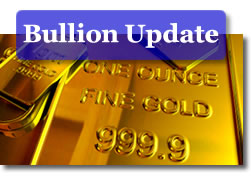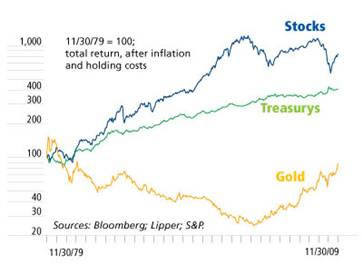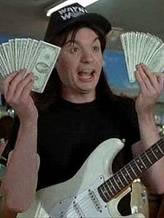 New York gold futures rose Thursday to close out the year and record the ninth consecutive annual gain. A drop in the US dollar was cited as the catalyst in improving the yellow metal’s attraction.
New York gold futures rose Thursday to close out the year and record the ninth consecutive annual gain. A drop in the US dollar was cited as the catalyst in improving the yellow metal’s attraction.
In other commodities, silver and platinum also climbed while crude oil finished higher for the seventh day and marked the biggest gain in a decade. US stocks ended the final 2009 trading day on a sour note, but registered exceptional yearly increases of between 20-45 percent.
New York precious metal figures follow:
-
Gold for February delivery advanced $3.70, or 0.3 percent, to $1,096.20 an ounce. It ranged from $1,093.10 to $1,107.60. In 1999, gold settled at $289.60 an ounce. The yellow metal gained 24 percent during the year.
-
Silver for March delivery climbed 4.3 cents, or 0.3 percent, to close at $16.845 an ounce. It ranged from $16.780 to $17.105. Silver jumped 49 percent on the year.
- January platinum rose $7.70, or 0.5 percent, to end at $1,460.00 an ounce. It ranged from $1,451.60 to $1,466.50.
In PM London bullion, the benchmark AM gold price was fixed to $1,104.00 an ounce, which was an increase of $16.50 from Wednesday. Silver rose 7 cents to $16.990 an ounce. Platinum was settled at $1,466.00 an ounce, gaining $11.00.
Notable bullion quotes follow:
"In a nice bookend to the year, it appears that 2009 will end much the way it started in the financial markets, a dollar story," Brian Kelly, chief executive of Kanundrum Research, a commodities and macroeconomic research firm, said on MarketWatch. "For gold the catalyst in 2010 will be inflationary pressures."
"The purchasing power of all currencies is being eroded," James Turk, the founder of Jersey, Channel Islands-based GoldMoney.com, said on Bloomberg. "I look at the real price of goods and I see hyperinflation for the dollar in the not-too-distant future. That means a declining value of the dollar and higher gold prices."
"Year-end book-squaring continued during the overnight hours, this time in favor of gold, oil, and the euro for a change, as a rather large wave of dollar selling hit the market and brought the US currency to just under 77.50 on the trade-weighted index," wrote Jon Nadler, senior analyst at Kitco Metals, Inc. "Bargain hunting by locals over in India helped support the move to higher ground in gold." [Read Nadler’s full commentary.]
Gold, considered a hedge during times of high inflation and economic uncertainty, tends to follow oil and move opposite to the U.S. dollar. A rising greenback makes dollar-denominated commodities, like bullion, more expensive for holders of other world currencies.
Oil and gasoline prices
Oil prices climbed for the seven day and marked their biggest annual gain in the last ten years. New York crude-oil for February delivery rose 8 cents, or 0.1 percent, to $79.36 a barrel, marking a 78% increase for the year.
"The proximity to $80 is attracting more speculators," Eugen Weinberg, an analyst with Commerzbank AG in Frankfurt, said on Bloomberg. "Events in Iran are also increasing the geopolitical premium. But I think prices are inflated at these levels and we’ll see a drop in early January."
The national average for regular unleaded gasoline jumped 1.6 cents $2.639 a gallon, according to AAA fuel data. That is 5.5 cents higher than last week, 1.2 cents more than a month back, and $1.022 above the price of a year ago.
U.S. Stocks
U.S. stocks declined "in a thinly-traded session on the last day of 2009 as investors mulled a better-than-expected report on initial jobless claims at the end of a big year on Wall Street," wrote Alexandra Twin of CNNMoney.
Twin notes that as of Wednesday’s close, the Dow advanced 20.2 percent, the S&P 500 rose 24.7 percent, and the Nasdaq jumped 45.1% percent.
For the final trading day of the year, the Dow Jones industrial average lost 53.13 points, or 0.51 percent, to 10,495.38. The S&P 500 Index retreated 3.83 points, or 0.34 percent, to 1,122.59. The Nasdaq Composite Index fell 6.22 points, or 0.27 percent, to 2,285.06.
Gold, Silver, and Metals: Prices and Commentary – Dec. 31
by Jon Nadler, Kitco Metals Inc.
Good Day,
Year-end book-squaring continued during the overnight hours, this time in favor of gold, oil, and the euro for a change, as a rather large wave of dollar selling hit the market and brought the US currency to just under 77.50 on the trade-weighted index. Bargain hunting by locals over in India helped support the move to higher ground in gold, albeit the stand-out performer early this morning was palladium. The noble metal gained 2% to vault above the $400 -its highest level since July of 2008. As expected, we have seen some hefty day-to-day moves in gold since the middle of last week, and a good portion of them were counterintuitive as well as outsized but that’s the nature of thinly traded markets.
Gold prices moved within a ten dollar range of from $1096 to $1106 as the thinning ranks of participants made a few final trades for what has turned out to be a very good year. The New York spot bullion price dealings opened with a $12.60 per ounce gain in gold, which was quoted at $1104.70 against the aforementioned slippage on the dollar index and against a 1.440 tick in the USD/EUR pair. Silver showed a 22-cent gain on the open, quoted at $16.97 per ounce. Platinum rose $9 to start at $1464 and palladium climbed $10 to the $402 level per troy ounce. Rhodium was $20 higher than our last reported $2340 level.
No doubt, the ‘big’ question, for some, on this, the last trading day of 2009, is whether gold closes at, under, or above the $1100 mark. It may not matter all that much, since, as of this writing, the final gold return tally for this, the ninth straight year of prices gains in the metal, stands above the 25% mark and the average price for the year, is at $972.35 per ounce. Obviously, many a buyer’s focus is on that profit metric. However, when it comes to that yardstick, "poor man’s gold" is set to finish the year with a 50% gain -obviously, double that of its presumptive price leader – you know, the one that got all the headlines.
And then, there is platinum. The unrealized paper gains for that unique metal stand at 63.5% after having held it for the past 365 days. Palladium? Glad you asked. Had you bought it at $183 an ounce a year ago, you would have a 219% return on the investment. A number that is neck-in-neck with the other stand-out performer in the precious metals complex: rhodium (at 220%). Said it once, will say it again: gold (in general) is not for ‘making money’ but for preserving it. If return on capital (rather than the return of it, as the adage goes) is the object of your desires, and your sense of timing and available discretionary funds are both there, well, the above performance metrics speak for themselves. It’s white, not gold, when it comes to ‘green.’ As for ‘black’ well, oil is set to end the year up nearly 80%, the biggest yearly gain since 1999.
Elliott Wave analysis (as of last night) opines that: "Gold remains on track to continue working lower over time. Shorter term, there are many potentials, including a bigger near-term bounce. If spot prices close beneath $1181.20 tomorrow [today], and the odds are pretty high that they will, gold will register a major bearish reversal bar on the monthly charts."
As mentioned last week, at $1100 an ounce, gold closes the year 29.9% higher than its three-year average level of $846.56 per ounce, and each one of those three 12-month periods can easily be classified as having been ‘in crisis.’ A return to that three-year average cannot and should not be ruled out in the coming year. However, neither should the presence of a core 10% allocation in the yellow metal in one’s portfolio, come whatever may. And now, a bit of year-end (and forward-looking) wisdom from a name that is not unfamiliar to those in the ‘golden’ niche.
Forbes fills us in on his thoughts: "Value maven Jean-Marie Eveillard is no trendy gold bug, but he suggests individuals put 5% to 10% of their assets into the metal. Eveillard believes the current level of economic uncertainty is so great, and so much depends on the Fed getting things right, that gold is one store of value that no value investor should ignore.
For individuals "a stake below 5% is irrelevant and anything more than 12% becomes more than insurance," the Parisian native says in a noticeable accent. Insurance against precisely what, Eveillard doesn’t claim to know. He believes the Fed’s actions are critical to how things play out.
But don’t go into this with quick trading profits in mind, warns Eveillard. The risk that gold’s price could sink by a few hundred dollars is especially prevalent at a time like this–when fear remains in the air, prices of gold and other commodities have been bubble-like and late-night TV pitchmen are offering to buy gold jewelry sight unseen. The metal’s price is also highly sensitive to the dollar and, thus, the U.S. economy. Its price could take a hit if growth picks up and rising interest rates make U.S. Treasurys more appealing. "If authorities engineer a recovery that is not inflationary it would be a considerable negative for gold," he says. "All of a sudden tax revenues would increase and the credit of governments would look better."
Forbes Editor William Baldwin reinforces Mr. Eveillard’s advice -but, with plenty of caveats. It’s all in the individual’s perspective, says he. The key take-home assignment however, is the same as we noted up above, and one that is frequently heard in James Turk’s own presentations: Gold is not an investment, despite being many other good things.
Says Mr. Baldwin that there is: "No question that having 10% of your savings in the heavy metal would have taken the edge off the sharp losses you probably experienced in the past two years. But don’t let recent history warp your thinking. Look at several decades of results before concluding that gold is a moneymaker. Also psychoanalyze yourself. What is it about this barbarous relic that attracts you?
Half of precious metals investors are thrill seekers. Volatility turns them on. Lately, these gold bugs have had the time of their lives. Maybe there’s no harm done. Investing in an exchange-traded bullion fund is no worse than spending money at the racetrack. The other half of buyers has the reverse need–a way to reduce the month-to-month jitters in their net worth. If you are in the jitterbug category, Eveillard is talking to you. Yes, there have been times when rising gold prices would have offset losses in stocks or bonds or both. At other times, it didn’t do its job. When the world’s financial system was on the verge of collapse a little over a year ago, gold wasn’t doing particularly well.
At what cost do you purchase this insurance policy? The chart displays the real return on gold since 1979. I have docked gold prices for a 0.4% annual custody cost (that being the fee for the most popular gold ETF available today) and for the cost of living. On this scale gold looks like a "nothingburger" of an investment."

So, what will 2010 bring with it: more of the same, or a new paradigm? Whatever it turns out to be, remember, it matters not. There are, after all, much bigger "worry" items on the calendar as we go forward, since we are now (once again) being firmly assured that "The End" is really nigh (if not next year, then by 12.22.2012, for sure).
The putative return of Quetzalcoatl will just happen to also coincide with the final "departure" (from the living) of the US dollar but, booking and enjoying mega-profits in gold will seem like a futile exercise when trying to simply survive all the fire and brimstone (which, no one will, anyway). But, hey, in the interim, we have 1087 days to ‘go for it’ any which way we like to. Party on, Wayne! And not like it is 1999, but more like it is 2009…

Speaking of parties, and of 2009,
To all of our readers worldwide, we wish
A HAPPY, HEALTHY, AND MOST PROSPEROUS NEW YEAR!
Jon Nadler
Senior Analyst
Kitco Metals Inc.
North America
Blog: http://www.kitco.com/ind/index.html#nadler
In related US Mint bullion coin news of the day, read 2009 Bullion Gold Eagles Lead Sales.










